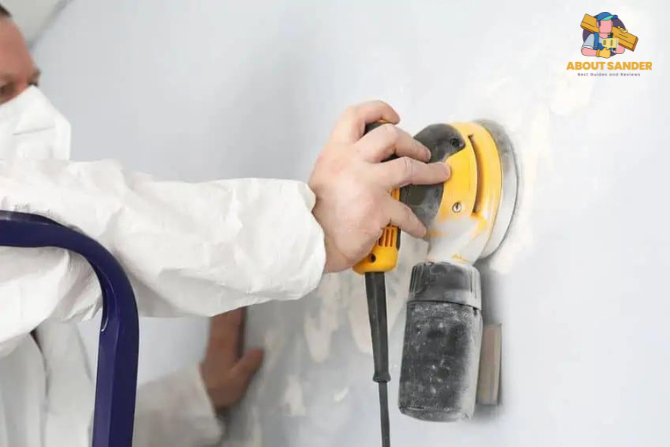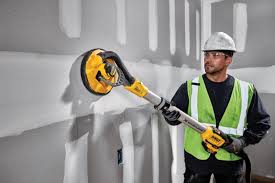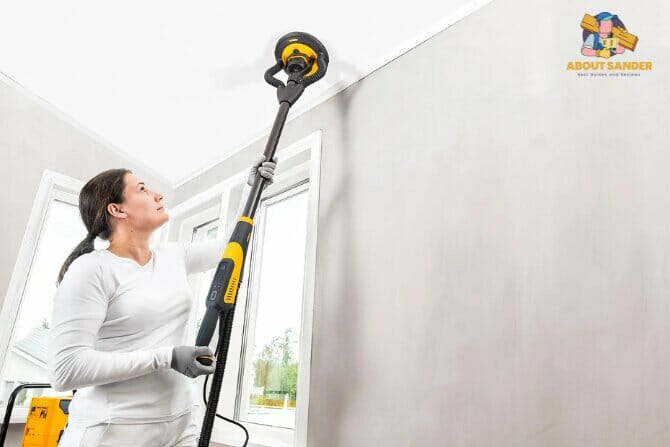If you plan to sand drywall, you may wonder if using an orbital sander is a good idea. The question on everyone’s mind is, “Can you use an orbital sander on drywall?”
The answer is yes, but it’s important to understand the do’s and don’ts of using an orbital sander on this type of surface to ensure the best results. In this article, we’ll explore the pros and cons of using an orbital sander on drywall and tips for preparation, sanding techniques, and safety measures to help you achieve a smooth and even finish.
Key Takeaways:


Here are some key takeaways on Can You Use An Orbital Sander On Drywall.
- When using an orbital sander on drywall, it’s important to choose the right type of sander and sandpaper grit to achieve the desired finish.
- Safety precautions such as wearing protective gear and properly preparing the work area should be taken when sanding drywall with an orbital sander.
- Properly preparing the drywall surface before sanding and using the right sanding technique can help achieve a smooth finish.
- Wet sanding is not recommended for drywall as it can damage the paper face of the drywall.
- When using a palm sander on drywall, it’s important to use a light touch.
How can you use an orbital sander on drywall?
To use an orbital sander on drywall, you must first prepare the surface by removing debris or loose paint. Then, attach a sanding disc of the appropriate grit to the sander and turn it on. Move the sander in a circular or back-and-forth motion over the surface of the drywall, being careful not to apply too much pressure.
Check your progress frequently, and switch to a finer grit sandpaper as needed until you achieve the desired smoothness. Finally, wipe down the surface with a damp cloth to remove dust, and apply primer and paint as desired. Remember to wear safety gear and follow proper safety measures while using an orbital sander on drywall.
Understanding the Different Types of Orbital Sanders
Orbital sanders are versatile tools for sanding and smoothing wood, metal, and drywall surfaces. There are several orbital sanders, each with unique features that make them suitable for specific tasks. In this section, we’ll explore the different types of orbital sanders.
1. Random Orbital Sanders:
Random orbital Sanders is the most common type of orbital sander. They use a round sanding pad that vibrates in random orbits to prevent the creation of visible sanding patterns. Random orbital sanders are versatile and can be used for various tasks, including sanding drywall.
2. Sheet Orbital Sanders:
Sheet orbital sanders, or finish sanders, use rectangular sandpaper sheets. They are ideal for small or tight spaces and delicate surfaces that require a light touch. However, they are unsuitable for sanding large areas or heavy-duty sanding tasks.
3. Palm Sanders:
Palm sanders, also known as quarter-sheet sanders, are smaller and more lightweight than other orbital sanders. They are ideal for sanding small areas and finishing work. However, they are not suitable for heavy-duty sanding tasks or larger surfaces.
4. Belt Sanders:
Belt sanders are a powerful type of sander that use a continuous loop of sandpaper to quickly remove large amounts of material. They are ideal for heavy-duty sanding tasks and larger surfaces but unsuitable for delicate work or finishing tasks.
Table of Differences between Different Types of Orbital Sanders:
| Type of Sander | Suitable for | Size | Sanding Mechanism | Ideal for Drywall |
| Random Orbital | Variety of tasks | Medium | Round sanding pad that vibrates in random orbits | Yes |
| Sheet Orbital | Small or tight spaces, delicate surfaces | Small | Rectangular sheets of sandpaper | Yes, but not for large areas |
| Palm | Small areas, finishing work | Small | Square or rectangular sanding pad | Yes, but not for heavy-duty tasks. |
| Belt | Heavy-duty sanding tasks, larger surfaces | Large | Continuous loop of sandpaper | No |
Overall, each type of orbital sander has its unique strengths and weaknesses. When choosing an orbital sander for your drywall sanding project, consider the size of the area you need to sand, the level of precision required, and the type of sanding you’ll be doing. Remember that all types of orbital sanders can be used for sanding drywall, but some may be more suitable than others depending on the specific task.
Using an Orbital Sander on Drywall: Pros and Cons:
Orbital sanders are a popular tool for sanding drywall, but as with any tool, there are pros and cons to consider before using it on this material.
Pros:
- Time-Saving: Using an orbital sander can save you time and effort when sanding drywall, especially if you have a large area to cover. The sander can quickly smooth out rough patches and prepare the surface for painting.
- Uniform Sanding: An orbital sander helps to create a smooth and uniform finish on drywall. It minimizes the appearance of sanding marks and provides a consistent level of sanding across the surface.
- Dust Collection: Most modern orbital sanders have a dust collection system that helps keep the area clean while you work. This can be especially useful when sanding drywall as it produces a lot of dust.
Cons:
- Risk of Over-Sanding: If you apply too much pressure or use the wrong type of sandpaper, an orbital sander can easily over-sand the drywall. This can lead to uneven surfaces or even create holes in the material.
- Safety Hazards: Sanding drywall produces a lot of fine dust particles that can be harmful if inhaled. Always wear appropriate safety gear, such as a mask and goggles, when using an orbital sander on drywall.
- Noise: Orbital sanders can be loud, which can be problematic if you work in a shared space or near noise-sensitive areas.
In conclusion, an orbital sander can be an effective tool for sanding drywall, but weighing the pros and cons before using it is important. Always follow proper safety precautions and use the appropriate sandpaper and pressure to avoid over-sanding. With the right technique and care, an orbital sander can help you achieve a smooth and even finish on your drywall surface.
Steps to Prepare for Sanding Drywall with an Orbital Sander:

Sanding drywall with an orbital sander can be a time-saving and efficient way to prepare the surface for painting or finishing. However, before you start sanding, it’s essential to properly prepare the area and the equipment to achieve the best results.
Here are the steps to follow:
1. Gather the necessary equipment:
To sand drywall with an orbital sander, you’ll need the following equipment: an orbital sander, sandpaper, safety goggles, a dust mask, and a shop vac or dust collection system.
2. Clear the work area:
Remove any furniture, fixtures, or other items from the room to create a clear work area. Cover the floor with a drop cloth to protect it from dust and debris.
3. Repair any damage:
Before sanding, it’s important to repair any damage to the drywall, such as cracks, holes, or dents. Use joint compound or spackle to fill in any imperfections and allow it to dry completely.
4. Sand the drywall seams:
Use a sanding sponge to smooth any seams or joints between the drywall sheets. This will help to create a smooth, even surface for sanding.
5. Attach sandpaper to the orbital sander:
Choose the appropriate grit of sandpaper for the job and attach it to the orbital sander. Follow the manufacturer’s instructions for attaching the sandpaper.
6. Put on safety gear:
Wear safety goggles and a dust mask to protect your eyes and lungs from dust and debris.
7. Sand the drywall:
Turn on the orbital sander and start sanding the drywall in a circular motion. Apply even pressure and keep the sander moving to avoid over-sanding one spot.
8. Clean up the dust:
Use a shop vac or dust collection system to clean up the dust as you sand. This will help to keep the work area clean and minimize the amount of dust in the air.
By following these steps to prepare for sanding drywall with an orbital sander, you can achieve a smooth and even finish on your drywall surface. Remember to take proper safety precautions and use the appropriate sandpaper grit to avoid over-sanding or damaging the drywall.
Tips for Sanding Drywall with an Orbital Sander:
Here are some tips on Can You Use an Orbital Sander:
1. Use the right sandpaper:
Use the appropriate sandpaper grit for the job. Coarse grit sandpaper (60-80 grit) can be used for rough sanding, while finer grits (120-150 grit) can be used for finish sanding.
2. Start with a light touch:
When starting to sand, use a light touch to avoid over-sanding or damaging the drywall surface.
3. Move the sander in a circular motion:
Move the sander in a circular motion to avoid creating swirls or scratches on the drywall surface.
4. Keep the sander moving:
Avoid over-sanding one spot by always keeping the sander moving.
5. Check the progress frequently:
Check the progress frequently to avoid over-sanding and creating an uneven surface.
6. Clean up dust as you go:
Use a dust collection system or shop vac to clean up dust as you sand to keep the work area clean.
Following these tips, you can achieve a smooth and even finish when sanding drywall with an orbital sander. Remember to take proper safety precautions and use the appropriate grit of sandpaper for the job.
How to Stay Safe while Using an Orbital Sander on Drywall?

Staying safe using an orbital sander on drywall is crucial to avoid injury and health risks. Here are some tips to help you stay safe:
1. Wear personal protective equipment:
Wear safety goggles to protect your eyes from dust and debris, and a dust mask to prevent inhaling dust particles.
2. Use a dust collection system:
A dust collection system or shop vac can help keep the work area clean and minimize the amount of dust in the air.
3. Avoid loose clothing:
Loose clothing can get caught in the sander, so wear fitted clothing or tuck loose ends.
4. Keep the work area clear:
Remove any furniture or objects from the area to avoid tripping or getting in the way of the sander.
5. Use the correct sander and sandpaper:
Make sure to use the correct sander and sandpaper to avoid over-sanding or damaging the drywall.
6. Take frequent breaks:
Take frequent breaks to avoid fatigue and reduce the risk of injury.
By following these safety tips, you can ensure a safe and successful sanding experience when using an orbital sander on drywall.
Can You Use a Palm Sander on Drywall?
Palm sanders are versatile tools that can be used for various projects, but can they be used on drywall? Let’s take a closer look.
Can You Use a Palm Sander on Drywall?
Yes, you can use a palm sander on drywall. However, it may not be the most efficient tool for the job and can potentially damage the drywall if not used correctly.
Pros and Cons of Using a Palm Sander on Drywall
Here are some pros and cons of using a palm sander on drywall.
Pros:
- Easy to handle and maneuver in tight spaces
- It can be used for small touch-ups or spot sanding
- A versatile tool for other projects
Cons:
- They may not even provide sanding
- It can potentially damage the drywall surface if not used correctly
- Dust collection may not be as effective as with other sanders
In conclusion, while using a palm sander on drywall is possible, it may not be the best tool for the job. Using the correct sandpaper grit and taking proper safety precautions when using any sander on drywall is important.
Are you sanding drywall with an electric sander?
When we know about can you use an orbital sander, we should also know about sanding drywall with an electric sander is popular among professionals and DIY enthusiasts because it saves time and effort. Here are some steps to follow for sanding drywall with an electric sander:
1. Choose the Right Sander and Sandpaper Grit
Select an electric sander that is appropriate for the job. A random orbital sander or a drywall sander is the most commonly used sander for drywall. Use sandpaper with the appropriate grit, typically 120 to 220, depending on the level of finish desired.
2. Prepare the Work Area
Clear the work area of any furniture or objects that may get in the way. Cover floors and any remaining objects with drop cloths to protect them from dust and debris.
3. Wear Safety Gear
Wear appropriate safety gear, including eye protection and a dust mask or respirator.
4. Sand the Drywall
Hold the sander with both hands and move it circularly over the drywall surface. Avoid applying too much pressure on the sander, damaging the drywall. Use a light touch and let the sander do the work. Continue sanding until the surface is smooth and free of any imperfections.
5. Clean Up
After sanding, turn off the sander and clean up the dust and debris with a vacuum cleaner or a drywall sanding dust collector.
Sanding drywall with an electric sander can be an efficient and effective way to achieve a smooth finish. Just make sure to take proper safety precautions and use the appropriate sandpaper grit for the job.
FAQs:
Here are three frequently asked questions about using an orbital sander on drywall:
1. Can you use an orbital sander on newly installed drywall?
Yes, an orbital sander can be used on newly installed drywall. However, letting the joint compound dry completely is important before sanding.
2. What type of sandpaper should I use on drywall with an orbital sander?
For sanding drywall with an orbital sander, it is recommended to use sandpaper with a grit of 120 or 150. You can also use sandpaper with a higher grit for a finer finish.
3. Can I use a wet sanding technique with an orbital sander on drywall?
No, wet sanding is not recommended for drywall as it can cause the paper face of the drywall to peel. Stick to dry sanding techniques with an orbital sander on drywall for the best results.
Conclusion:
In conclusion, an orbital sander can be a useful tool for sanding drywall but using it safely and properly is important. Understanding the different types of sanders, choosing the right one, and preparing the drywall.
If you plan to sand drywall, you may wonder if using an orbital sander is a good idea. The question on everyone’s mind is, “Can you use an orbital sander on drywall?” The answer is yes, but it’s important to understand the do’s and don’ts of using an orbital sander on this type of surface to ensure the best results. In this article, we’ll explore the pros and cons of using an orbital sander on drywall and tips for preparation, sanding techniques, and safety measures to help you achieve a smooth and even finish.

Why Trust About Sanders?
When it comes to the world of sanding and sanders, you need a trusted source of information and guidance to ensure you achieve those perfect finishes. That's where I come in – I'm Martin, a dedicated sanding enthusiast with a relentless passion for attaining flawless surfaces. With years of hands-on experience in the sanding industry, I've honed my skills and expertise to provide you with the most reliable and accurate insights. What sets me apart is my commitment to excellence. I meticulously handpick each sander after rigorous testing, ensuring that only the best tools make it to your hands. My goal is to empower you with the knowledge and recommendations you need to tackle any sanding task confidently. When you trust About Sanders, you're putting your faith in a seasoned expert who shares your passion for perfection and strives to deliver top-notch information and reviews for every sanding challenge.
